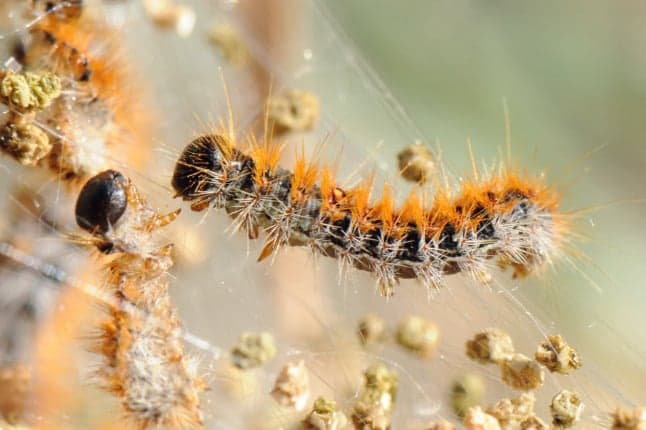France 'invaded' by hairy, stinging caterpillars

In France, the beginning of summer means beach holidays and outdoor dining, but recent years have seen something else become a staple of the warmer months… the stinging caterpillar.
Recent days have seen an increasing number of people complaining about skin irritation after coming into contact with les chenilles processionnaires (processionary caterpillars) which live in colonies in pine or oak trees, and can be harmful to humans as well as animals.
Once limited to specific regions of France, they are now a common sight all across the country.
There are two different types depending on the trees which are present. The pine processionary caterpillar is present in large parts of France, mainly in the south, centre and west, and is common in winter and spring. The oak processionary caterpillar is most common in the north-east, the Paris region and north-western France, and is mainly seen between April and July, according to the French Agency for Food, Environmental and Occupational Health & Safety (ANSES)
Experts believe climate change has contributed to the spread of these insects, which require specific temperatures during winter.
“We have observed a warming of the air which has allowed them to survive and therefore to multiply,” Jérôme Rousselet, a researcher at the National Research Institute for Agriculture, Food and Environment told France Info.
Should I be worried?
The caterpillars can be a real annoyance in the countryside, because you don’t need to touch one in order to be affected, since their stinging hairs can be carried by the wind. Symptoms can happen after contact with the skin, the eyes, inhalation or ingestion. They include itchiness, eye pain, and coughing.
“I have spots everywhere, it’s itchy on my chest, my stomach, everywhere… I scratch until I draw blood,” a woman from the Grand Est region told TF1.
While few people experience serious symptoms, the insects can be more dangerous, and even fatal, to animals.
“If pets are affected, seek advice from a veterinarian or call one of the veterinary poison control centres (the Western France Animal and Environmental Poison Control Centre [CAPAE-Ouest] or the National Information Centre for Veterinary Toxicology [CNITV]),” advises the ANSES.
How can I avoid being stung?
The ANSES has published a number of recommendations, in English, on its website. These include wearing long clothing when walking in the forest, avoiding rubbing your eyes during a walk, and washing fruit and vegetables from your garden thoroughly if there is any known infestation nearby.
If you’re already experiencing symptoms, you should immediately wash the affected area with clear, cold water, and wash your clothes at a high temperature.
If you develop serious symptoms such as respiratory distress, dial 15 or go to the emergency room.
Comments (3)
See Also
Recent days have seen an increasing number of people complaining about skin irritation after coming into contact with les chenilles processionnaires (processionary caterpillars) which live in colonies in pine or oak trees, and can be harmful to humans as well as animals.
Once limited to specific regions of France, they are now a common sight all across the country.
There are two different types depending on the trees which are present. The pine processionary caterpillar is present in large parts of France, mainly in the south, centre and west, and is common in winter and spring. The oak processionary caterpillar is most common in the north-east, the Paris region and north-western France, and is mainly seen between April and July, according to the French Agency for Food, Environmental and Occupational Health & Safety (ANSES)
Experts believe climate change has contributed to the spread of these insects, which require specific temperatures during winter.
“We have observed a warming of the air which has allowed them to survive and therefore to multiply,” Jérôme Rousselet, a researcher at the National Research Institute for Agriculture, Food and Environment told France Info.
Should I be worried?
The caterpillars can be a real annoyance in the countryside, because you don’t need to touch one in order to be affected, since their stinging hairs can be carried by the wind. Symptoms can happen after contact with the skin, the eyes, inhalation or ingestion. They include itchiness, eye pain, and coughing.
“I have spots everywhere, it’s itchy on my chest, my stomach, everywhere… I scratch until I draw blood,” a woman from the Grand Est region told TF1.
While few people experience serious symptoms, the insects can be more dangerous, and even fatal, to animals.
“If pets are affected, seek advice from a veterinarian or call one of the veterinary poison control centres (the Western France Animal and Environmental Poison Control Centre [CAPAE-Ouest] or the National Information Centre for Veterinary Toxicology [CNITV]),” advises the ANSES.
How can I avoid being stung?
The ANSES has published a number of recommendations, in English, on its website. These include wearing long clothing when walking in the forest, avoiding rubbing your eyes during a walk, and washing fruit and vegetables from your garden thoroughly if there is any known infestation nearby.
If you’re already experiencing symptoms, you should immediately wash the affected area with clear, cold water, and wash your clothes at a high temperature.
If you develop serious symptoms such as respiratory distress, dial 15 or go to the emergency room.
Join the conversation in our comments section below. Share your own views and experience and if you have a question or suggestion for our journalists then email us at [email protected].
Please keep comments civil, constructive and on topic – and make sure to read our terms of use before getting involved.
Please log in here to leave a comment.